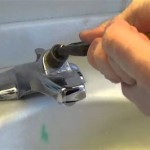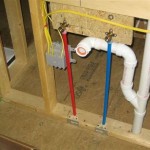Changing Faucets In Bathroom Sink: A Comprehensive Guide
Replacing a bathroom faucet is a common home improvement project that can refresh the look of a bathroom and potentially improve water efficiency. While professional plumbers can handle this task, a homeowner with basic plumbing knowledge and the right tools can often complete the project independently. This article provides a detailed guide to changing faucets in a bathroom sink, covering preparation, removal of the old faucet, installation of the new faucet, and necessary troubleshooting.
Preparing for the Project
Before starting any plumbing project, preparation is crucial. Proper preparation not only makes the task easier but also reduces the risk of complications and potential water damage. The first step is to gather all the necessary tools and materials. A typical list includes:
* New Faucet: Choose a faucet that fits the sink's hole configuration (single-hole, centerset, widespread) and meets the desired aesthetic and functionality requirements. Ensure the new faucet comes with all necessary parts, including mounting hardware, gaskets, and supply lines.
* Adjustable Wrench: This versatile tool is essential for loosening and tightening nuts and bolts.
* Basin Wrench (Sink Wrench): This specialized wrench is designed to reach up into tight spaces under the sink to loosen and tighten nuts on the faucet supply lines and mounting hardware.
* Pliers (Channel-Lock Pliers): Useful for gripping and manipulating parts, especially when loosening corroded or stubborn connections.
* Screwdriver (Phillips and Flathead): Necessary for removing and installing screws that may be present in the faucet mounting hardware.
* Putty Knife or Scraper: For removing old plumber's putty or caulk around the old faucet.
* Plumber's Putty or Silicone Caulk: To create a watertight seal between the faucet and the sink.
* Teflon Tape (Plumber's Tape): To seal threaded connections and prevent leaks.
* Bucket and Towels: To catch any residual water and protect the surrounding area from spills.
* Safety Glasses: To protect the eyes from debris.
* Work Gloves: To protect the hands.
* Penetrating Oil (Optional): To help loosen corroded nuts and bolts.
* Flashlight or Headlamp: To provide adequate lighting under the sink.
Once the tools and materials are gathered, the next step is to shut off the water supply to the faucet. Locate the shut-off valves under the sink. There should be two valves, one for hot water and one for cold water. Turn both valves clockwise until they are completely closed. If the shut-off valves are old or corroded and do not function properly, it may be necessary to shut off the main water supply to the house. If this is the case, inform all household members that the water will be temporarily unavailable.
After shutting off the water supply, open the faucet to relieve any remaining pressure in the lines. Place a bucket under the faucet supply lines to catch any residual water that may be present. Disconnect the supply lines from the shut-off valves. Have a towel handy to wipe up any spills.
Removing the Old Faucet
With the water supply shut off and the area prepared, the next step is to remove the old faucet. This can be the most challenging part of the project, especially if the faucet has been in place for many years and the connections are corroded.
Begin by disconnecting the supply lines from the faucet. Use the basin wrench to loosen the nuts that connect the supply lines to the faucet tailpieces. These nuts can be difficult to reach and may be corroded, so patience and careful maneuvering are essential. If the nuts are heavily corroded, applying penetrating oil and allowing it to soak for a few minutes may help loosen them.
Once the supply lines are disconnected, locate the mounting hardware that secures the faucet to the sink. This hardware typically consists of nuts, washers, and a mounting bracket. Use the basin wrench or an adjustable wrench to loosen and remove the nuts. The location and configuration of the mounting hardware can vary depending on the type of faucet. Some faucets may have a single large nut that secures the entire assembly, while others may have multiple smaller nuts.
After removing the mounting hardware, carefully lift the old faucet from the sink. Be prepared for some resistance, as the faucet may be stuck due to old plumber's putty or caulk. Use a putty knife or scraper to carefully break the seal between the faucet and the sink. Once the seal is broken, the faucet should lift out easily.
With the old faucet removed, thoroughly clean the sink surface around the faucet holes. Remove any remaining plumber's putty, caulk, or debris. Use a cleaning solution to remove any residue and ensure a clean surface for the new faucet.
Installing the New Faucet
The installation of the new faucet begins with carefully reading the manufacturer's instructions. Each faucet model is slightly different, and following the specific instructions provided by the manufacturer is crucial for a successful installation. Generally, the installation process involves the following steps:
First, attach the supply lines to the new faucet. If the new faucet comes with flexible supply lines, simply screw them into the faucet tailpieces. Be sure to use Teflon tape on the threads to create a watertight seal. If the new faucet requires separate supply lines, connect them to the faucet tailpieces using compression fittings or other appropriate connectors. Again, use Teflon tape on the threads to ensure a leak-free connection.
Next, install the mounting hardware. Place the new faucet into the sink holes and align it properly. From underneath the sink, attach the mounting bracket, washers, and nuts. Tighten the nuts securely, but be careful not to overtighten them, as this could damage the sink or the faucet. Ensure the faucet is firmly seated and does not wobble.
Apply a bead of plumber's putty or silicone caulk around the base of the faucet where it meets the sink. This will create a watertight seal and prevent water from seeping under the faucet. Smooth the putty or caulk with your finger to create a clean, professional-looking finish. Remove any excess putty or caulk with a damp cloth.
Connect the supply lines to the shut-off valves. Use an adjustable wrench to tighten the connections securely. Again, be careful not to overtighten the connections, as this could damage the valves or the supply lines. Ensure the supply lines are not kinked or twisted.
Once all connections are made, slowly turn on the water supply to both the hot and cold water valves. Check for leaks around the faucet base, the supply line connections, and the shut-off valves. If any leaks are detected, tighten the connections further or reapply Teflon tape if necessary.
After verifying that there are no leaks, test the faucet by running both hot and cold water. Check the water pressure and ensure that the water flows smoothly. Also, check the drain to ensure that it is functioning properly.
Troubleshooting Common Issues
Even with careful preparation and installation, some issues may arise when changing a bathroom faucet. This section addresses some common problems and offers potential solutions.
Leaks: Leaks are the most common issue encountered after installing a new faucet. Leaks can occur at various points, including the faucet base, the supply line connections, and the shut-off valves. To address leaks, first, identify the source of the leak. If the leak is at the faucet base, tighten the mounting hardware and reapply plumber's putty or silicone caulk. If the leak is at a supply line connection, tighten the connection further or reapply Teflon tape. If the leak is at the shut-off valve, the valve may need to be replaced.
Low Water Pressure: If the water pressure is low after installing the new faucet, there may be a blockage in the supply lines or the faucet itself. Check the supply lines for kinks or twists and straighten them if necessary. Remove the faucet aerator and clean it to remove any debris. If the water pressure is still low, the faucet cartridge may need to be replaced.
Loose Faucet: If the faucet feels loose or wobbly, the mounting hardware may not be tightened sufficiently. Tighten the mounting nuts from underneath the sink, ensuring the faucet is firmly seated. If the faucet continues to feel loose, the mounting hardware may be damaged or missing and may need to be replaced.
Difficulty Removing Old Faucet: Removing the old faucet can be challenging, especially if the connections are corroded. Using penetrating oil and allowing it to soak for a while can help loosen corroded nuts and bolts. If the nuts are too corroded to turn, a bolt extractor may be necessary. In some cases, it may be necessary to cut the supply lines or mounting hardware with a hacksaw to remove the old faucet.
Drain Issues: Sometimes, replacing a faucet can disturb the drain connection, leading to leaks or clogs. Ensure the drain assembly is properly connected and tightened. Clean the drain stopper and trap to remove any debris. If the drain is clogged, use a drain snake or plunger to clear the blockage.
By following these steps and addressing any issues that arise promptly, a homeowner can successfully change a faucet in a bathroom sink and enjoy a refreshed and functional bathroom fixture.

How To Replace A Bathroom Faucet Removal And Installation

How To Replace A Bathroom Faucet Tinged Blue

How To Replace A Bathroom Faucet Removal And Installation

Diy How To Replace A Bathroom Sink Faucet Remove Install

How To Install A Bathroom Faucet The Home Depot

How To Install A Bathroom Faucet The Home Depot

How To Replace A Bathroom Faucet Removal And Installation

How To Replace A Bathroom Faucet Home Repair Tutor

How To Replace A Bathroom Faucet The Home Depot

Replacing A Bathroom Faucet Fine Homebuilding
Related Posts







